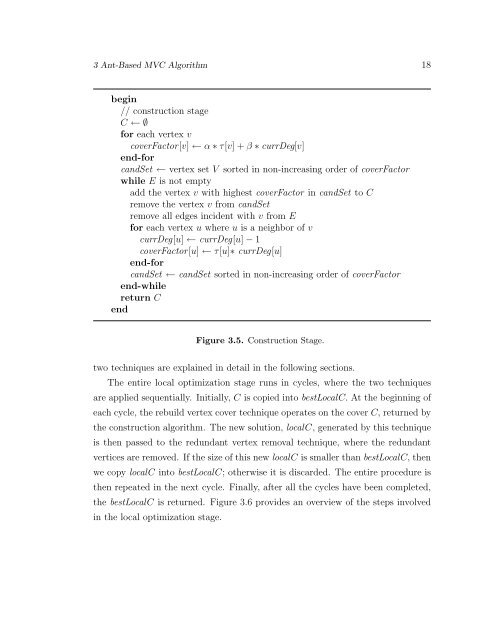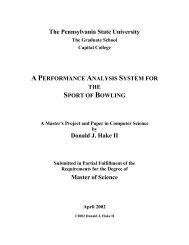An Ant-Based Algorithm for the Minimum Vertex Cover Problem
An Ant-Based Algorithm for the Minimum Vertex Cover Problem
An Ant-Based Algorithm for the Minimum Vertex Cover Problem
You also want an ePaper? Increase the reach of your titles
YUMPU automatically turns print PDFs into web optimized ePapers that Google loves.
3 <strong>An</strong>t-<strong>Based</strong> MVC <strong>Algorithm</strong> 18begin// construction stageC ← ∅<strong>for</strong> each vertex vcoverFactor[v] ← α ∗ τ[v] + β ∗ currDeg[v]end-<strong>for</strong>candSet ← vertex set V sorted in non-increasing order of coverFactorwhile E is not emptyadd <strong>the</strong> vertex v with highest coverFactor in candSet to Cremove <strong>the</strong> vertex v from candSetremove all edges incident with v from E<strong>for</strong> each vertex u where u is a neighbor of vcurrDeg[u] ← currDeg[u] − 1coverFactor[u] ← τ[u]∗ currDeg[u]end-<strong>for</strong>candSet ← candSet sorted in non-increasing order of coverFactorend-whilereturn CendFigure 3.5. Construction Stage.two techniques are explained in detail in <strong>the</strong> following sections.The entire local optimization stage runs in cycles, where <strong>the</strong> two techniquesare applied sequentially. Initially, C is copied into bestLocalC. At <strong>the</strong> beginning ofeach cycle, <strong>the</strong> rebuild vertex cover technique operates on <strong>the</strong> cover C, returned by<strong>the</strong> construction algorithm. The new solution, localC, generated by this techniqueis <strong>the</strong>n passed to <strong>the</strong> redundant vertex removal technique, where <strong>the</strong> redundantvertices are removed. If <strong>the</strong> size of this new localC is smaller than bestLocalC, <strong>the</strong>nwe copy localC into bestLocalC; o<strong>the</strong>rwise it is discarded. The entire procedure is<strong>the</strong>n repeated in <strong>the</strong> next cycle. Finally, after all <strong>the</strong> cycles have been completed,<strong>the</strong> bestLocalC is returned. Figure 3.6 provides an overview of <strong>the</strong> steps involvedin <strong>the</strong> local optimization stage.
















